Blue whales are magnificent creatures that have graced our oceans for over one million years.
Did you know that the blue whale is the largest known animal to have ever lived on earth? A mere 200 years ago, there were thought to be over 350,000 of these awesome mammals in our oceans. Today, thanks to human activity, there are around just 25,000 blue whales left in the wild, and that’s a tragedy.
These amazing animals are classified as endangered, but much is being done to save them, and you can help too!
Keep reading to learn more blue whale facts and find out what you can do to help them.
Blue Whale Information
Here are some points about the majestic blue whale.
What Does a Blue Whale Look Like?

Blue whales (Balaenoptera musculus) are long, streamlined animals having enormous, broad heads with a unique U-shaped arch that can extend to a quarter of the animal’s entire body length.
The whale has a gray or mottled blue back and a pale underbelly. The flippers are thin and elongated, and the dorsal fin is sickle-shaped and situated close to the whale’s tail. The tail flukes are thin and wide.
Like all baleen whales, blue whales are filter feeders. The animal’s jaw is lined with between 70 and 395 black baleen plates that the whale uses to extract krill and plankton from the water. To enable the whale to gulp down vast quantities of food, its grooved throat can expand like a concertina when the animal is feeding.
Blue whales breathe through two blowholes, blasting up to 40 feet up into the air!
Locomotion

Blue whales are slender and streamlined to help them swim efficiently, which is essential during the animals’ migration across hundreds of miles in search of food.
Take a look at your pet goldfish, and you’ll see that he moves his tail horizontally to propel himself through the water. In contrast, cetaceans move their flukes vertically to generate more power with less effort.
Whales’ flippers (pectoral fins) are actually modified forelimbs with a fixed elbow joint that the whales use mostly for steering. The small dorsal fin keeps the whale stable and on an even keel as it swims.
Blubber
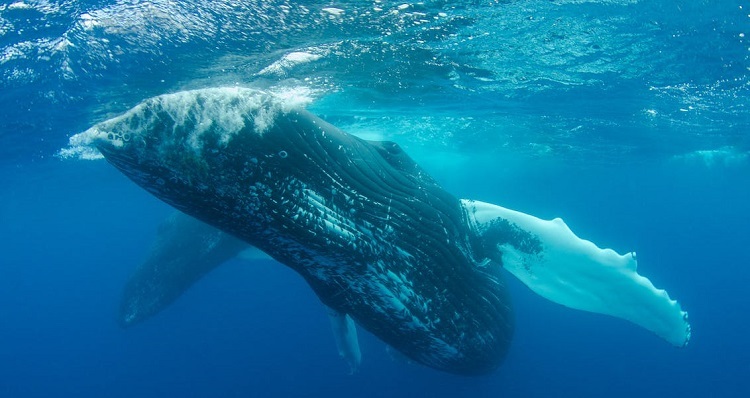
Whales have a layer of fat called blubber that covers the creature’s entire body under the skin. Blubber is much thicker than the fat found on other animals and less dense than seawater. That works like a wetsuit, providing the whale with buoyancy and helping it to float.
Rather than keeping the whale warm, blubber provides the creature with the nutrients it needs when food is scarce.
Blubber thickness varies between species, but blue whale blubber can be up to 4 feet thick!
Brain Power
Although the blue whale is the largest animal on earth, its brain is only the second largest, weighing just over 11 pounds. The sperm whale has the largest brain of all, which can weigh as much as 13 pounds.
Is a Blue Whale a Mammal?
Many people think that blue whales are fish, like sharks.
However, blue whales are actually baleen marine mammals. How so?
Blue whales are mammals, meaning that they have hair, and three inner ear bones, breathe air, and suckle their young on mother’s milk produced by mammary glands. Now, blue whales are obviously not hairy! Instead, cetaceans have blubber to insulate them, and any hair they are born with is shed as the whale matures.
In fact, all whale species have hair on their bodies when they are born, usually in the form of sensory hairs on the head and jaw. Some whales retain that hair, while most species shed them.
Blue Whale Size
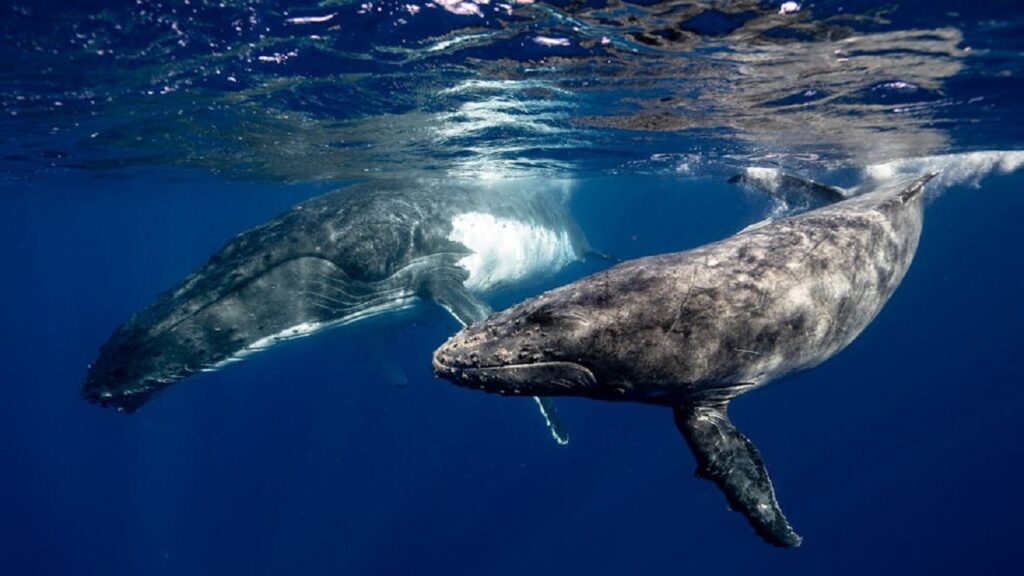
Blue whales are the largest animals to have ever existed on earth.
Statistics from the International Whaling Commission report whales measuring longer than 98 feet and weighing up to 300,000 pounds.
Female blue whales are typically larger than males.
How Big Is a Baby Blue Whale?
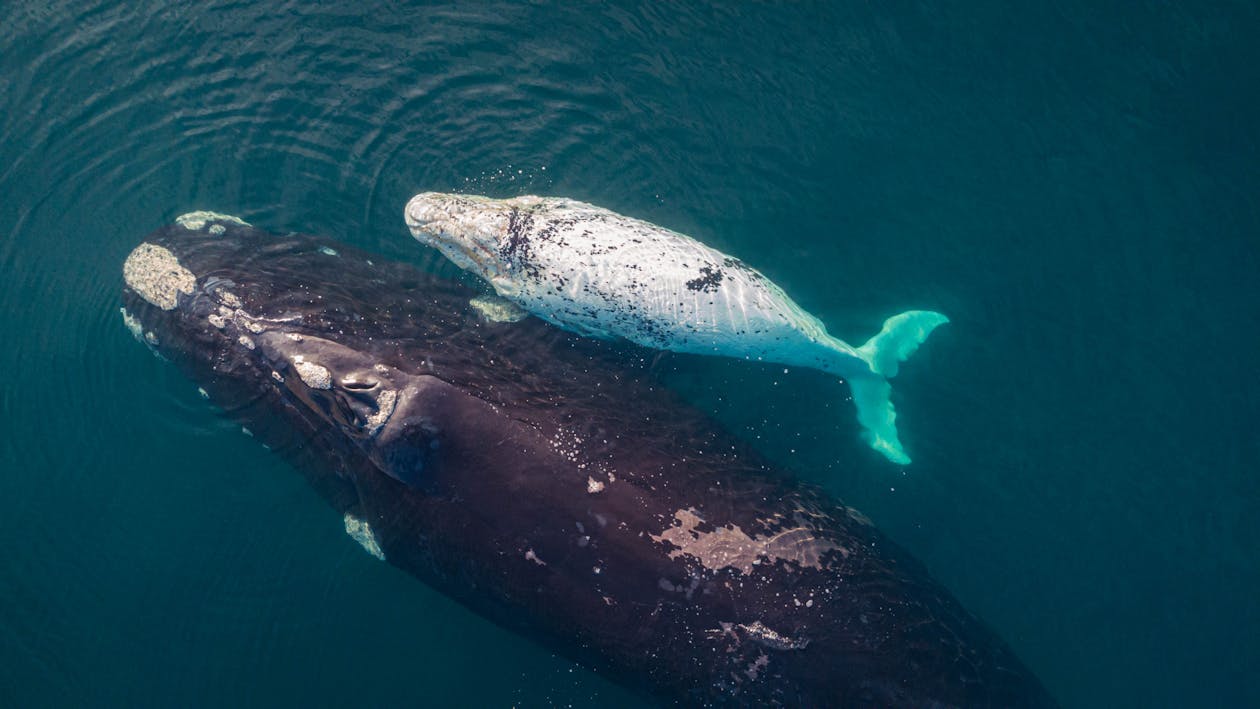
Females are pregnant for around one year before giving birth and have a blue whale calf every two to four years.
At birth, the blue whale calf is around 23 feet long, weighing between 5,000 and 6,000 pounds.
To keep her “little” baby fed, its mother must produce more than 50 gallons of milk daily!
How Long Is a Blue Whale?
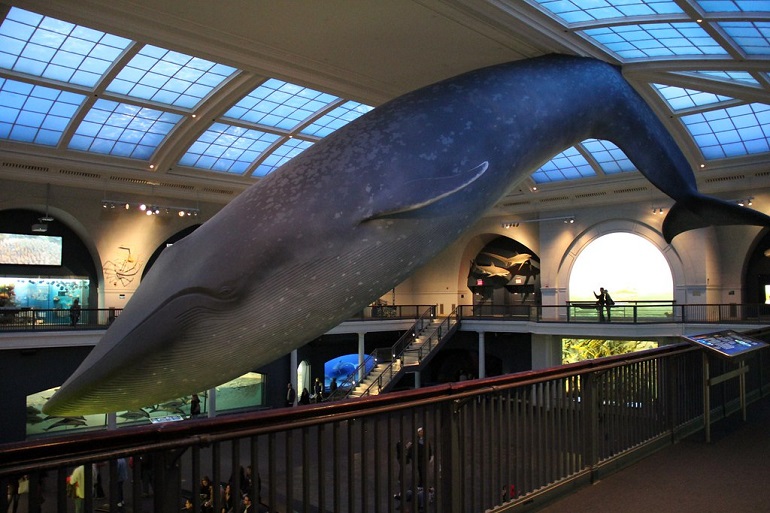
Adult blue whales can grow to around 98 feet long, although a few unconfirmed specimens of this gargantuan marine mammal have been measured at over 100 feet long.
Blue Whale Tongue

A blue whale’s tongue is the largest in the animal kingdom and can weigh as much as 5,400 pounds. That’s as much as an elephant!
Blue Whale Tail
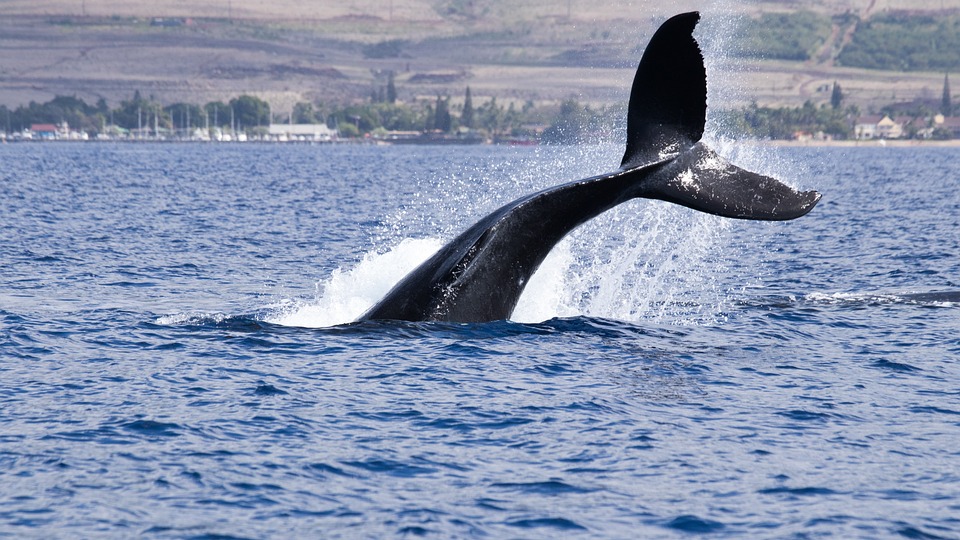
A blue whale’s tail is called a fluke. The fluke measures between 20 and 25 feet wide and is used to propel the animal smoothly through the water.
Blue Whale Life Span
Scientists estimate a whale’s age by counting layers of a waxy substance collected from deceased specimens. It’s thought that a blue whale’s lifespan is between 80 and 90 years, although the oldest blue whale was estimated at over 100 years old!
Blue Whale Species
There are four subspecies of blue whales, which are categorized depending on where they are found.
- B. musculus musculus or Northern blue whale, found in the North Pacific and North Atlantic Oceans
- B. musculus intermedia or Antarctic or Southern blue whale, found in the Southern Ocean
- B. musculus indica, Indian Ocean blue whale, found in the Indian Ocean
- B. musculus brevicauda, or pygmy blue whale, found in the Southern Oceans
Some of these subspecies overlap during migrations in search of food and mates.
Where Do Blue Whales Live
Blue whales are found in every ocean on the planet except the Arctic Ocean.
The whales typically migrate every year between summer and winter feeding grounds, although there is evidence to suggest that some whales prefer to stay in the same place rather than migrate.
Blue whale migration routes are not well-known, although it’s assumed they are driven by krill availability since the whales tend to congregate where large concentrations of krill are found.
Blue Whale Range
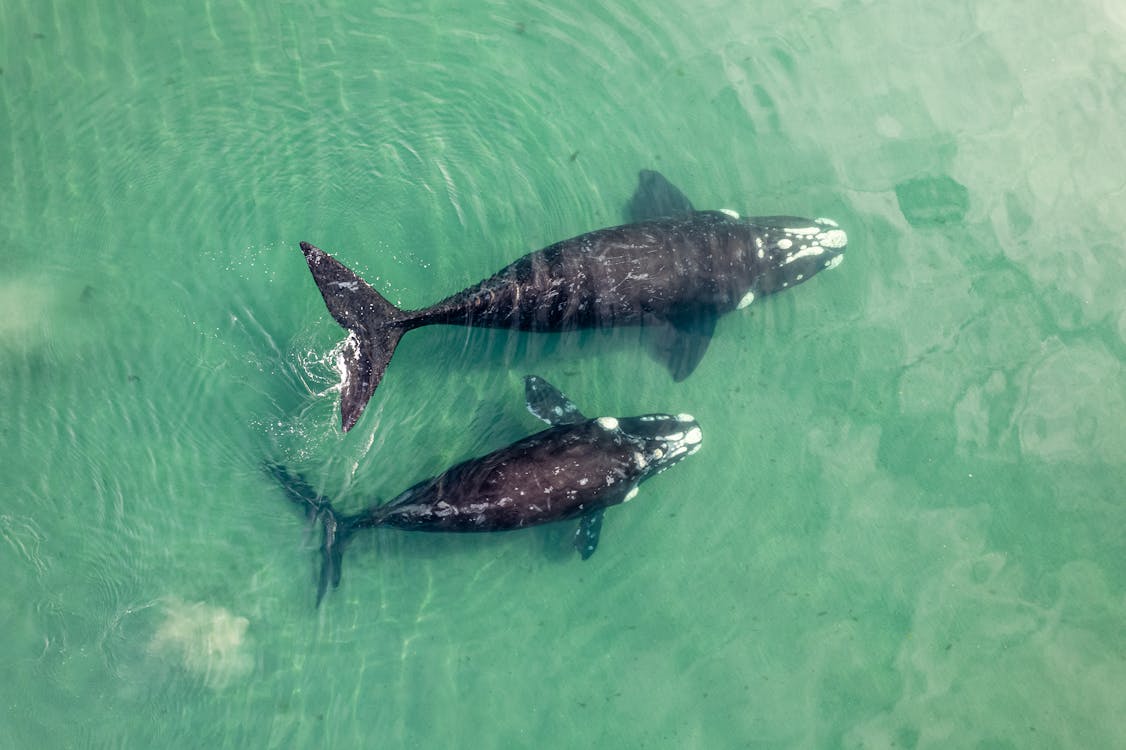
Whales in the North Atlantic range from subtropical waters to the Greenland Sea. Spotters have seen blue whales off eastern Canada and in the shelf waters of the eastern US.
Eastern North Pacific blue whales spend the winter in the warm waters of Central America, Mexico, and the US West Coast. It’s thought these whales feed throughout the summer in the central North Pacific, the Gulf of Alaska, and off the US West Coast.
Interestingly, blue whale mothers and blue whale calves are often seen in what’s thought to be an important nursery and calving area in the Gulf of California from December through March.
Resident Populations
There’s a resident population of blue whales in the northern Indian Ocean, specifically in the Arabian Sea, the Bay of Bengal, and the Gulf of Aden. Some whales might migrate, but their movements are not fully understood. However, oceanographic changes related to the monsoons could explain why the whales leave.
Some Antarctic blue whales in the Southern Hemisphere migrate to low and middle latitudes during the winter months, although some don’t migrate at all.
An as-yet-unnamed blue whale species is found in the Southeastern Pacific Ocean, especially the Chiloense Ecoregion. These whales migrate to the eastern tropical Pacific and the waters around the Galapagos Islands.
Pygmy Blue Whales
The Pygmy blue whale is a subspecies found in the waters of Madagascar, Australia, and New Zealand.
Blue Whales Fact-File
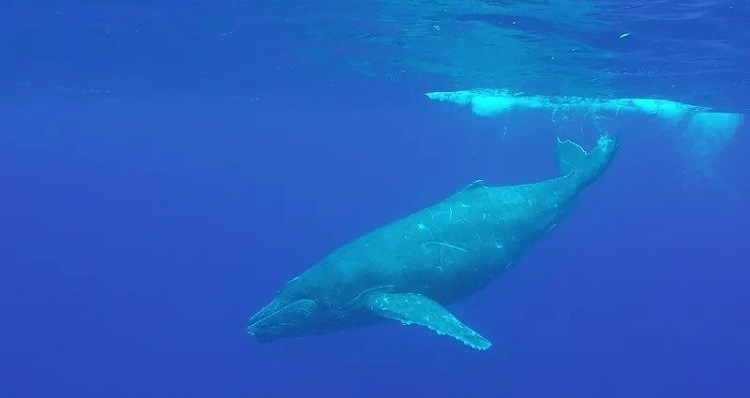
The blue whale is also known as the sulfur-bottom whale. Cold water diatoms stick to the whale’s skin, giving the animal’s underbelly a yellowish tinge, which is where that other common name comes from.
Blue whales belong to the phylum Chordata, the class Mammalia, the Order Cetacea, and the family Balaenopteridae. These mammals have the scientific genus-species classification Balaenoptera musculus andbelong to the Kingdom Animalia, like humans!
10 Blue Whale Interesting Facts
- Blue whales were almost hunted to extinction by whaling ships until the species was given protection in 1966.
- Male blue whales have the largest penis in the whole animal kingdom, measuring around 9.8 feet long!
- The word “whale” is derived from the Anglo-Saxon word “hwael,” which literally means “a large fish.”
- Whales, porpoises, and dolphins are known as cetaceans.
- Blue whales are shallow divers despite their massive size and power, descending to no more than 330 feet since that’s where their prey is.
- Blue whales are the loudest animals on earth, capable of making a sound that other blue whales can hear at a distance of over 500 miles.
- Blue whales have a cruising speed of around 5 mph, although they can produce sudden bursts of speed up to 20 mph when necessary.
- During the 1900s, blue whale blubber was prized for its oil, used in soap, margarine, and oil lamps. That led to extensive hunting that nearly wiped out the species.
- Female blue whales typically only give birth to one calf at a time.
- Blue whale mothers lift their newborn calf to the water’s surface so that it can take its first breath. Other female whales nearby sometimes help by gently nudging the calf to encourage it to breathe.
It’s unthinkable that we could lose the remarkable blue whale in the foreseeable future. Keep reading to find out how you can help prevent that.
10 Blue Whale Facts for Kids
If we are to save the blue whale for future generations, it’s essential that these amazing creatures capture our kids’ imagination.
With that in mind, here are some cool blue whale facts your kids can use to impress their classmates and teachers!
- Thanks to its streamlined shape, the blue whale looks just like a submarine when viewed from the side.
- Blue whale flippers account for only 12% of the animal’s body size. That’s pretty puny, yet the whales use their flippers to steer their huge bulk through the water.
- Blue whales are mammals, not fish.
- Blue whales are carnivores that don’t eat vegetables or algae.
- Just like you and me, blue whales sleep! The whale’s body shuts down completely, but half the animal’s mind remains alert so that the whale remembers to breathe!
- You know the old story of Jonah, who a giant whale swallowed? So, that’s a myth! A blue whale cannot physically swallow a human. Although a whale’s mouth is massive, its throat is much smaller than you think, being only around the size of your fist!
- A blue whale is much bigger than any dinosaurs discovered to date, even Tyrannosaurus Rex!
- Blue whales are actually gray! However, the sunlight and color of the water make the whales’ backs appear dark blue, and that’s where they get their name.
- Blue whales communicate through a series of very low-pitched moans and whines at a volume of around 168 decibels. That’s louder than a jet engine!
- Blue whale babies are the quickest-growing creatures on the planet, piling on a ridiculous 200 pounds per day!
We think you’ll agree that these creatures are truly incredible and worth saving for future generations.
Blue Whale Diet

The blue whale eats a diet that consists almost entirely of krill. Krill are mini shrimp-like crustaceans found throughout the oceans. The whales dive into massive swarms of krill with their enormous mouths gaping open, guzzling down more food in one mouthful than any other animal on the planet.
Blue whales are filter feeders, having an expandable, concertina-like structure that enables the animal to engulf more prey and water than its own body weight.
The water and prey cocktail is pushed out of the whale’s mouth by its massive tongue through baleen plates hanging from the animal’s upper jaw, leaving only the nutritious krill behind.
Blue Whale Predators
Blue whales are so large that they have few predators.
Unfortunately, man is the predator that has caused the massive decline in blue whale numbers. For centuries, the oceans were plundered, and blue whales were taken for their blubber. So many whales were slaughtered that their slow reproduction rate couldn’t replenish numbers quickly enough to meet the demand.
In the North Atlantic, it’s estimated that around 11,000 blue whales were harvested between the end of the 19th century and the 1960s. Thankfully, the hunting of blue whales is now banned in those waters, and numbers are slowly recovering.
Orca
Killer whales or Orcas are the only other predator of the blue whale. That said, not all Orcas include whales in their diet, which tends to vary between populations.

Orcas hunt in closely coordinated teams or packs when chasing prey, usually targeting calves or weak adult whales. In images taken by researchers in the Gulf of California in Mexico, 25% of the whales pictured had Orca teeth marks on their flukes.
However, that fluke can be used as a formidable weapon. The 25-foot wide tail can frighten away or even kill a predator with one powerful slap.
Blue Whale Threats
Blue whales can sometimes be injured by ship strikes or can become entangled in fishing nets and gear.
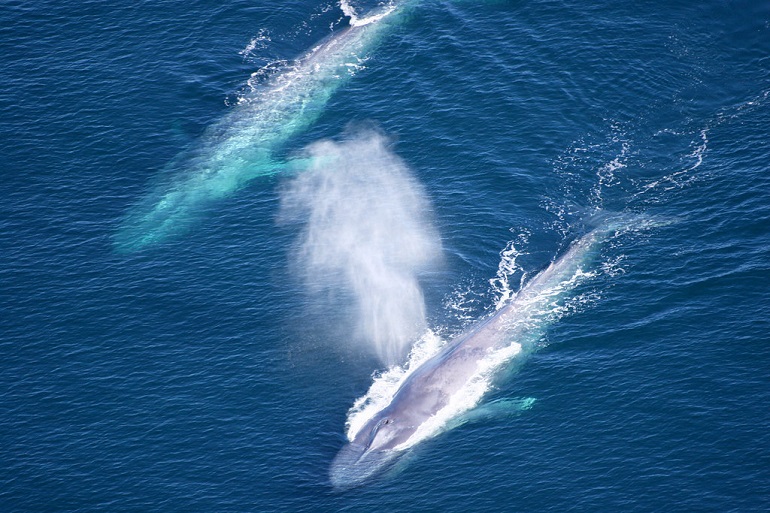
Pollution and habitat loss are also threats all large ocean-going animals face, including blue whales, many species of sharks, and whale sharks.
However, perhaps more concerning is the effect of climate change on the numbers of krill in the world’s oceans since the tiny crustaceans are the blue whales’ primary food source. Without a ready supply of krill, blue whales would struggle to survive.
Are Blue Whales Endangered?
As of March 2018, the blue whale is listed by the IUCN as being endangered.
However, blue whale numbers are noted to be increasing, which is fabulous news. In addition, blue whales are now protected under the Marine Mammal Protection Act of 1972.
Conservation Status
So, under the ESA, the blue whale is classified as endangered throughout its natural range and is therefore considered depleted under the MMPA.
Fortunately, since 1966 blue whales have been internationally legally protected from all commercial whaling thanks to the International Convention for the Regulation of Whaling.
How Can You Help?
You can help protect the blue whale by donating to research programs and raising awareness of the plight of other endangered species in the oceans.
FAQ’s
Here are the answers to a few commonly asked questions about the magnificent blue whale.
How Many Days Can Blue Whales Survive Without Food?
Blue whales constantly eat, gobbling up an estimated 10 to 20 tonnes of krill every single day! That equates to between 20 and 50 million calories consumed each day in the feeding season when krill are plentiful
It’s thought that a blue whale can go without food for several months during the winter fasting season when food is not so readily available.
How Many Hearts Do Blue Whales Have?
Blue whales have one massive heart, and it’s a big one! A blue whale heart weighs an estimated 400 pounds, almost as much as a fully-grown lion!
Are Blue Whales Friendly in Nature?
Blue whales are gentle giants that are not aggressive toward humans.
Final Thoughts
I hope you enjoyed our fascinating guide to blue whale facts. If you loved the article, please take a moment to share it!
Blue whales have been cruising peacefully in our planet’s oceans for millennia. These giant filter feeders hold many world records, but that hasn’t protected them from devastating human exploitation during the latter part of the 17th and 18th centuries when whale numbers were decimated.
Today, blue whales are listed as endangered. However, thanks to changes in legislation, hunting them was banned internationally in 1966, and today, their numbers are slowly increasing.
Did you already take action to save blue whales? Well done! Tell us what you did in the comments box below!


